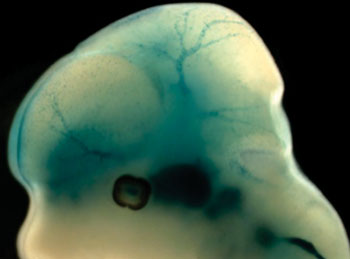Genetically Engineered Mouse Model Reveals Key to Formation of the Blood-Brain Barrier
By LabMedica International staff writers
Posted on 06 Jul 2015
Use of a mouse model that had been genetically engineered to lack the gene that encodes the forkhead transcription factor Foxf2 has helped to explain how pericytes, cells that line the capillaries, form and maintain the blood-brain barrier.Posted on 06 Jul 2015
Pericytes are critical for maturation of the brain's blood vessels and development of the blood-brain barrier, but their role in maintenance of the adult blood-brain barrier, and how central nervous system pericytes differ from those of other tissues, is less well understood.

Image: The photomicrograph shows the head of a mouse embryo in which the pericytes are visible as blue dots along the blood vessel (Photo courtesy of the University of Gothenburg).
Pericytes are contractile cells that wrap around the endothelial cells of capillaries throughout the body. Pericytes are embedded in basement membrane where they communicate with endothelial cells by means of both direct physical contact and paracrine signaling. In the brain, these cells are a key component of the neurovascular unit, which includes endothelial cells, astrocytes, and neurons. Pericytes help sustain the blood–brain barrier as well as several other homeostatic and hemostatic functions of the brain by regulating capillary blood flow, the clearance and phagocytosis of cellular debris, and the permeability of the blood–brain barrier. A deficiency of pericytes in the central nervous system can cause the blood–brain barrier to break down, resulting in inflammation or death of brain tissues.
Investigators at the University of Gothenburg (Sweden) recently demonstrated that the forkhead transcription factor Foxf2 was specifically expressed in pericytes of the brain and that embryos of mice genetically engineered to lack the gene for Foxf2 developed intracranial hemorrhages, perivascular edema, thinning of the vascular basal lamina, and a leaky blood-brain barrier.
FOX (Forkhead box) proteins are a family of transcription factors that play important roles in regulating the expression of genes involved in cell growth, proliferation, differentiation, and longevity. Many FOX proteins are important to embryonic development. FOX proteins also have pioneering transcription activity by being able to bind condensed chromatin during cell differentiation processes. The defining feature of FOX proteins is the forkhead box, a sequence of 80 to 100 amino acids forming a motif that binds to DNA.
"Mice that have too little or too much Foxf2 develop various types of defects in the brain's blood vessels," said senior author Dr. Peter Carlsson, professor of chemistry and molecular biology at the University of Gothenburg.
Major changes in a region of chromosome six have been associated with an increased risk of stroke, but it has not been known which of the genes in the area were responsible. "The Foxf2 gene is an extremely interesting candidate, as it is located right in the middle of this region, and research is under way now in collaboration with clinical geneticists to investigate the extent to which variations in the Foxf2 gene affect people's risk of suffering a stroke," said Dr. Carlsson.
The study was published in the June 25, 2015, online edition of the journal Developmental Cell.
Related Links:
University of Gothenburg







 Array (4-plex).jpg)




